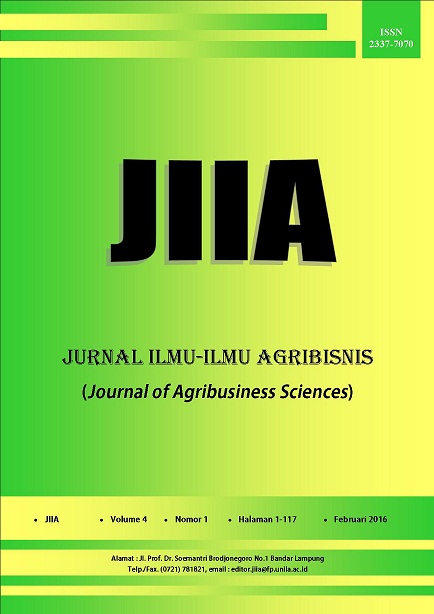ANALISIS KINERJA RANTAI PASOK DAN NILAI TAMBAH PRODUK OLAHAN KELOMPOK WANITA TANI MELATI DI DESA TRIBUDISYUKUR KECAMATAN KEBUN TEBU LAMPUNG BARAT
DOI:
https://doi.org/10.23960/jiia.v4i1.1211 Abstract View: 2904
Abstract View: 2904
Abstract
This study purposed to measure supply chain performance of KWT Melati products and analyze value added of KWT Melati products. This Research was conducted in Tribudisyukur Village at Kebun Tebu Subdistrict, West Lampung. The research data was collected on April 2015 using survey method. Sample size was 25 respondents who were selected using purposive sampling. Analysis Data Method used for supply chain management performance was Supply Chain Operation References (SCOR) 9,0 and for value added analysis was Hayami method. The result of this study showed that (1) Based on the result of this study, there is an ineffectiveness on management cost especially on Total Supply Chain Management Cost (TSMC) metric for all products of KWT Melati, this is caused by the amount of cost spent on producing (2) The most profitable product of KWT Melati is coffee package 25gr with value added ratio 55,68% and gave added value Rp52.400,00 for every kg coffee production.
Key words : women farmer group, supply chain performance, value added analysis
Downloads
Downloads
Published
How to Cite
Issue
Section
License
Authors who publish with this journal agree to the following terms:
Authors retain copyright and grant the journal right of first publication with the work simultaneously licensed under a Creative Commons Attribution License that allows others to share the work with an acknowledgement of the work's authorship and initial publication in this journal.
Authors are able to enter into separate, additional contractual arrangements for the non-exclusive distribution of the journal's published version of the work (e.g., post it to an institutional repository or publish it in a book), with an acknowledgement of its initial publication in this journal.
Authors are permitted and encouraged to post their work online (e.g., in institutional repositories or on their website) prior to and during the submission process, as it can lead to productive exchanges, as well as earlier and greater citation of published work (See The Effect of Open Access).














